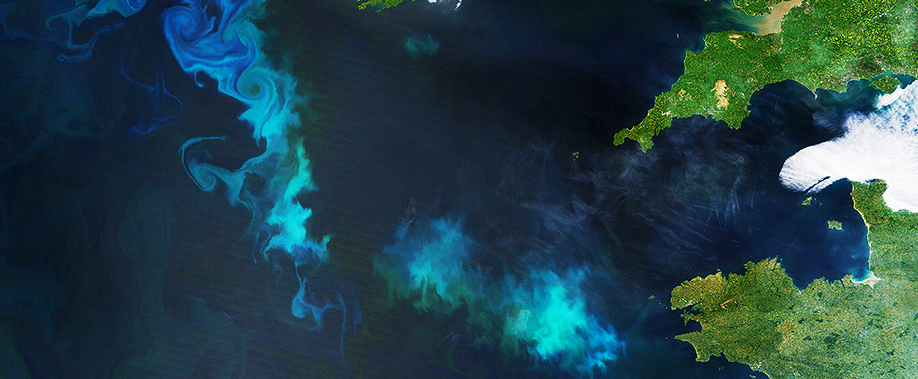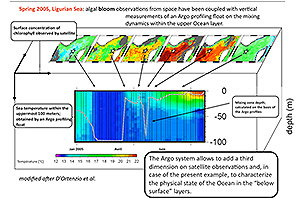Remote Sensing

Innovative observation strategies for biogeochemical studies today also become possible thanks to the combination of the two different kinds of remotely sensed platforms: undersea robots and "Ocean colour" satellites.
These have some characteristics in common, but a particular strength lies in their complementary character :
In common |
Complementary |
|
Both provide the same measurements of biogeochemical parameters (e.g. Chlorophyll-a, Colored Dissolved Organic Matter, backscattering coefficient). They acquire data at high temporal resolution. They both have long life times. Observations are autonomous and managed remotely. Their data are centralized, distributed in quasi real-time and in open access. |
While satellites observe the upper Ocean layer only, undersea robots allow to access to the vertical dimension by acquiring data from the Ocean surface down to 1000 meters and more. Satellites always follow the same measurement protocol. For undersea robots this can be changed in real-time. Satellites have a very high spatial resolution (~1 km) and a quasi-synoptic coverage, which is fixed and not changeable. For undersea robots, the user can modify the observation strategy (e.g. temporal resolution). |
Thanks to such characteristics, undersea robots are esteemed as being unique scientific tools and sources of multi-scale observations of biogeochemical Ocean properties, which are perfectly complementary to satellite observations. The ![]() robot/satellite coupling is thus considered as an essential component of future integrated observation systems.
robot/satellite coupling is thus considered as an essential component of future integrated observation systems.
 Such observation systems are also required to support Ocean biogeochemical and ecosystem modeling. They indeed contribute to set up model initial conditions as well as to evaluate model performance. Profiling floats with extended biogeochemical capabilities now can provide a much-needed perspective on the biogeochemistry of Ocean layers that have not been sampled sufficiently for modeling purposes in the past.
Such observation systems are also required to support Ocean biogeochemical and ecosystem modeling. They indeed contribute to set up model initial conditions as well as to evaluate model performance. Profiling floats with extended biogeochemical capabilities now can provide a much-needed perspective on the biogeochemistry of Ocean layers that have not been sampled sufficiently for modeling purposes in the past.
Ocean Color Sensors, e.g. :
- MERIS - Medium Resolution Imaging Spectrometer; Envisat-1 ; ESA (European Space Agency)
- MODIS - Moderate Resolution Imaging Spectroradiometer; Aqua; NASA (National Aeronautics and Space Administration/US)
- SeaWIFS - Sea-viewing Wide Field-of-view Sensor; NASA (National Aeronautics and Space Administration/US; end of mission in early 2011)